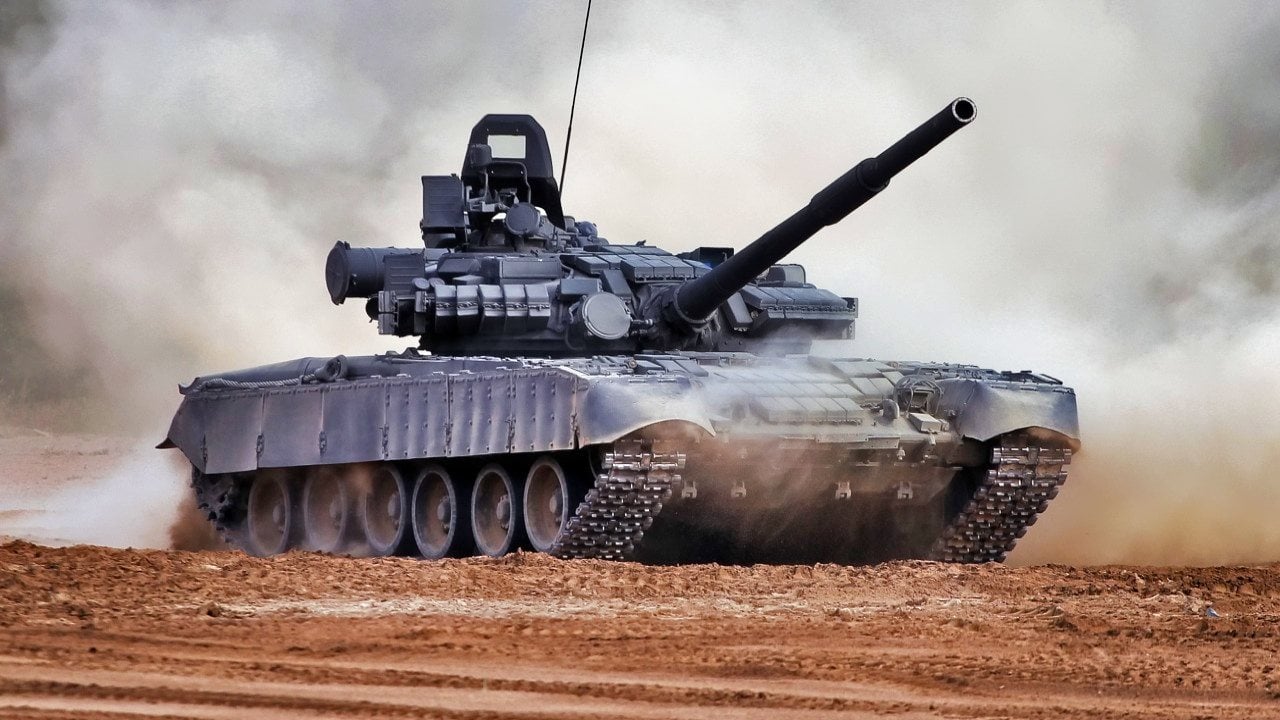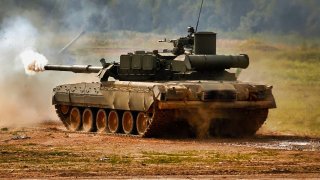Russia's Old T-80 Tank Is Getting Drone Protection for Ukraine War
Russia has equipped its latest batch of T-80BVM main battle tanks with "anti-drone" protection, according to Rostec, the military-industrial conglomerate.
Summary and Key Points: Russia has equipped its latest batch of T-80BVM main battle tanks with "anti-drone" protection, according to Rostec, the military-industrial conglomerate.

-The tanks, produced at Omsk Transport Engineering Plant, feature mesh screens and nets designed to protect vulnerable areas such as the engine, transmission compartment, and turret from drones, guided missiles, and shaped grenades.
-This development comes as Russian tanks have proven vulnerable to unmanned aerial systems in Ukraine. Previous ad hoc measures, like "cope cages" and "turtle tank" structures, were largely ineffective. The effectiveness of these new protections remains uncertain, given the T-80’s troubled combat history.
New Russian Tanks Coming With 'Anti-Drone' Protection
Russian military-industrial conglomerate Rostec announced on Thursday that it had equipped "anti-drone" protection on the latest batch of T-80BVM main battle tanks (MBTs). The tanks were produced at the Omsk Transport Engineering Plant and recently handed over to the Russian military.
"Omsktransmash, an affiliate of our concern UVZ has sent a batch of modernized T-80BVM tanks to the army. The vehicles are equipped with special mesh screens and nets that protect the engine and transmission compartment and the aft part of the turret from shaped grenades, guided missiles and FPV drones," Rostec said in a statement on its Telegram channel, according to a report from Russian state media outlet Tass.
The effectiveness of the anti-drone protection must be taken with a huge grain of salt.
Since soon after the start of the conflict, Russian MBTs were found to be vulnerable to unmanned aerial systems (UAS), which could be employed to drop ordnance into open hatched, while loitering munitions have also targeted the tanks striking at vulnerable locations, such as the aforementioned engine and transmission compartments. Russia troops responded with ad hoc solutions – including welding "cope cages" over the turrets and hulls, and even tying logs to the sides of the tanks.
Some desperate tank units have resorted to adding a shed-like superstructure over the entire body, resulting in a so-called "turtle tank." The corrugated metal has proven reasonably effective against aerial dropped bombs, and even to some extent against smaller loitering munitions; yet, it has impacted the maneuverability of the vehicles.
Now it seems that anti-drone protection is being employed even before the tanks are deployed from the frontlines. It needs to be seen if it is any more effective than the past efforts. Moreover, the Russian defense firm shows that it understands that even the modernized T-80 has been far from an effective platform in Ukraine.
The T-80 – Metal Deathtrap
The T-80 was the last true MBT developed by the Soviet Union, and though it was designed for speed, it didn't live up to its expectations.
When it was used in the First Chechen War (1994-96), it quickly fell victim to man-portable anti-tank weapons. The losses were so great, in fact, that it was even sidelined during the Second Chechen War in 1999 and the 2008 Russo-Georgian conflict. It probably wouldn't have seen service in the ongoing conflict in Ukraine had the Kremlin's forces made it to Kyiv in the planned three days.

It would be quick to suggest, the T-80 is better than nothing – but as Harrison Kass wrote for The National Interest, "The Russians have already lost roughly 700 T-80 tanks since the war began. The T-80's survivability problems are a common theme."
Welding "special mesh screens and nets" are unlikely to enhance the survivability, but at least it means that the crews won't be forced to find scrap metal to weld over their tanks.
Author Experience and Expertise: Peter Suciu
Peter Suciu is a Michigan-based writer. He has contributed to more than four dozen magazines, newspapers, and websites with over 3,200 published pieces over a twenty-year career in journalism. He regularly writes about military hardware, firearms history, cybersecurity, politics, and international affairs. Peter is also a Contributing Writer for Forbes and Clearance Jobs. You can follow him on Twitter: @PeterSuciu. You can email the author: [email protected].
Image Credit: Creative Commons.


